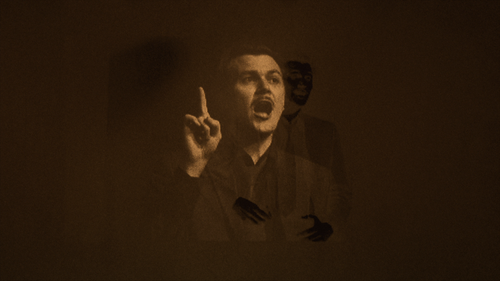
“Homo Sapiens Project is an ongoing series of personal video works by Rouzbeh Rashidi.... The films produced range from cryptic, often darkly surreal film diaries to impressionistic portraits of places and people, from found footage séances to semi-documentary monologues. Formally, they encompass everything from highly composed and distantly framed meditations to frenetically flickering plunges into the textural substance of moving images. They are also frequently often suffused with an eerie sense of mystery reminiscent of Horror and Classic Sci-Fi cinema. “
The Call had been my one-play from 2008, which I wrote and produced myself aswell as performed. The plays is about Mickey, a near-psychotic entrepeneur who rings up a rival in order to boast about his recent successes, but finds himself locked into an ever more extreme battle of one-upmanship, over girls, cars and money. It's structured around a telephone call in such a way that the audience only hears Mickey's side of the conversation, and had proved to be a very challenging piece of work, and constituted an important artistic breakthrough for me. However, my only record of the performance had been a scratchy DVD of one of the rehearsals, which had been lost until I stumbled upon it year or so ago, copying it to my hardrive, and there it languished for months.
I decided recently to send the recording to Rashidi, because I knew he liked to re-work old footage for Homo Sapiens Project. And I was not disapointed. Using digital post-production techniques, Rashidi transformed the material into a stunning new film: HSP 131 (ie – the 131st film in Homo Sapiens Project so far). The file I sent him was a 100MB MPEG, which he then converted and blew-up into a 40 GIG Apple Pro-Res 422 (HQ), it is a half hour multiple exposure of one continuous take. Rashidi eloborates on the aesthetic aspects of HSP 131: -
“The nature of HSP usually are rooted in horror and science fiction cinema with heavily presecence of eerie mood and mysteriousness. In this particular episode elements such as visual multi-layer activities, positive/negative imagery, sepia-tone, dark/drone ambient soundscape, and use of very light flickering effect are together in order to serve the enigmatic experience,and expose the situation of the uncanny character of the film”.
And further, on the new life given to my performance of The Call in HSP 131: -
“If we assume that the performance of James Devereaux is the heart and soul of the film, then it needed a brain/bodyi n order for it to come back to cinematic life...when the performance is good, the soul is there. The image and sound can be heavily changed and altered later on, thanks to digital cinema. Like we did in HSP 131”.
I think this is an important and fundamental point, which I am still coming to terms with. I thought that my work in The Call was essentially “dead” - the performances on stage can only live on in the memory of the audience, and the recording of the rehearsal was never really going to see the light of day, but Rashidi has given the performance a new life, or, to put it another way, a new body for a lost soul. I've written before on this blog, that it is the actor's job to be truthful, while the filmmaker supplies the fantasy (the actor is Alice in the filmmaker's Wonderland, as it were). Digital technology in the right hands then, possesses the power to take the same, truthful performance, and create a new, fantastical context for it.
No comments:
Post a Comment